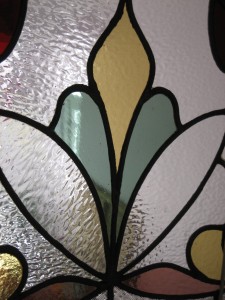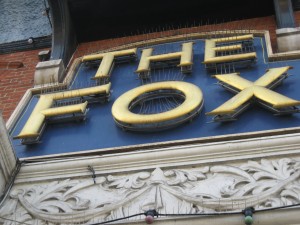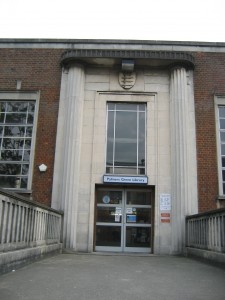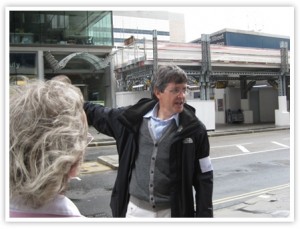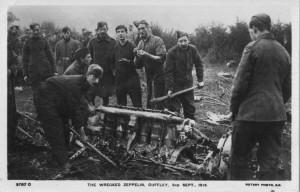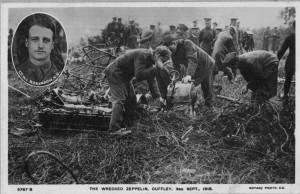Watch the news any day of the week and you will be reminded of how lucky we are to have lived our lives in peacetime. But many Palmers Green residents still remember a time of air raids and blazing fires, and daily encounters with the fragility of life.
At the start of the Second World War, the German Luftwaffe had predominantly targeted strategic sites – airfields, munitions factories and so on – but in autumn 1940 all that changed, bringing the period we now know as the Blitz. Between September and May 1941 there were 129 large scale raids on the UK, of which 71 were targeted on London. More than a million houses were destroyed in the capital alone and there were huge numbers of civilian casualties. By the middle of the war, more civilian women and children had been killed than soldiers.
Though, as with many parts of north London, Palmers Green saw its fair share of enemy action, the area suffered fewer hits than some of its neighbours nearer the Lea Valley.
But there was one terrible night that will never be forgotten by those who lived here through the war. Betty Wright’s father, Station Officer George Walton was one of the senior firemen based at Southgate Town Hall. Recalls Betty, Dad spent many many nights fighting the London Blitz, sometimes not coming home for three or four days….exhausted, dirty and hungry.”
An awful scene greeted him on the night of 5 March 1941 on Green Lanes, not far from the present day junction with the North Circular.
“One night in March 1941, the Dance Hall (held in the Princes Hall above Pitman’s College) in Green Lanes, Palmers Green was bombed. A German bomber ‘plane was overhead…and tragically his bomb carriage was blown off, so all the bombs came down together in Palmers Green.
One of my brothers returning from work was on a trolley bus, and he got off the bus one stop before his usual stop: the Town Hall. This action saved his life because immediately after he left the trolley bus, it was blown up. He never knew what made him get off before his usual stop. My brother arrived home covered in a white dust, and suffering from shock said “Pass me a clothes brush….I am in a mess”.
The Fire Brigade were there in seconds, and my Dad was one of the first on the scene. He came back with some horrific stories. He got on a double decker bus and it was as though everyone was standing or sitting exactly as they were before the bombs fell. People were still standing reading their newspapers, or sitting down….waiting for their bus stop. However, everyone was dead….killed by the blast.
Another brother was home on leave from the Royal Marines, he went down to see what was happening and came back later….filthy dirty and very tired…after helping as many of the injured he could. He said he would never forget the terrible scenes he had seen. There so many people who had lost their limbs.
A girl I was at school with (she would have been three years older than me) was in the Dance Hall and she lost a leg. I experienced many air raids in Palmers Green, but this was the worst.”
Mrs Wyn Whiddington was inside the dance hall, and later gave her account of the evening to the BBC project, the People’s War.
“The dance hall was packed, filling the upstairs of the building. Absolutely packed out. My friends and I sat out because we couldn’t do that dance. Everyone was dancing on the floor at the time.
There was a big draught of wind, you don’t hear anything. That was when the bomb dropped. Everything went dark. We had to be pulled out of the rubble. The whole floor was gone, empty, not a soul on it. Nobody.
Also a bus was hit outside as well at the same time. It was like daylight, the fire was so bright in the blackout.”
Though there were many injured, there were only 2 fatalities inside the dance hall. Sadly, it was a very different story outside. 41 people had been killed on the passing bus caught in the blast.
There is still a reminder of the terrible events of that night. 14 properties were destroyed and a further 17 had to be demolished. Of these, Barclays bank on the corner of Green Lanes and Sidney Road (141-143 Green Lanes), directly opposite the blast, was never rebuilt. The site is now used as a forecourt by Chiswick Tyres.
Kevin O’Neill of Southgate Photographic Society produced the revealing succession of pictures below, taking an original picture of the aftermath of the bombing (supplied by kind permission of Enfield Local Studies and Archive), and the former location of the dance hall, then combining the two to show where in incident took place in relation to our modern streets. See the full slideshow produced by SPA, in which old Palmers Green transforms to the new, by clicking here
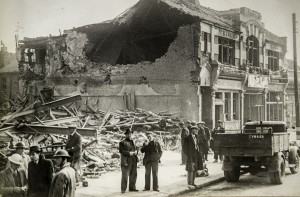
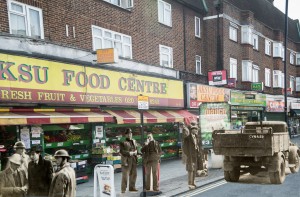
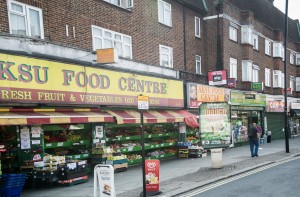
- Betty Wright would love to hear from anyone who remembers her family, the Waltons, who lived in a flat in Palmers Green Town Hall for over 50 years. If you would like to get in touch, please contact palmersgreenn13@btopenword.com and we will pass your email on.
- Are you interested in sharing your memories of the area? Palmers Green Tales is a new project about the people of Palmers Green, their lives, their memories, and their everyday experiences. More news soon, but if you would like to contact us in the meantime, please email palmersgreenn13@btopenworld.com
